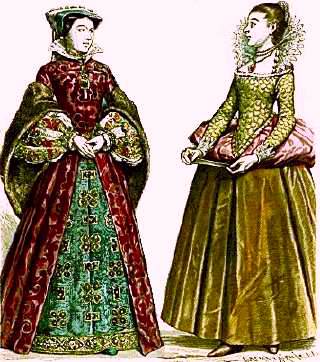Women's clothes
A woman's basic garment consisted of a bodice and skirt, or kirtle, with a "stomacher" joined by pins, hooks, or ties to the front of the bodice. A gown was sometimes worn over the bodice and kirtle. Sleeves were separate and joined to the bodice by ribbons, hooks or pins.
Necklines were varied; in the later Elizabethan period, and early in the reign of James I, they were often very low, revealing the bosom.
Footnotes
-
Hats
Women often went without hats, both in and out of doors, although some type of head covering was usual. The plainest was a white linen coif which hid most of the hair. The French hood, a small hood with a curved border at the front and material falling to the shoulder at the back, was popular, as was the similar Mary Stuart hood, made of sheer cloth and edged with lace. A "caul," or hairnet, made of gold mesh, silk thread, or even human hair, could be worn alone or with a hat.
Among the most stylish hats were the taffeta pipkin, a brimmed hat trimmed with ostrich feathers and jewels, and the court bonnet, a velvet pillbox adorned with feathers and jewels.
-
Stubborn Stubbes
That outspoken puritan, Philip Stubbes, was especially hard on women's clothes:
When they have all these goodly robes upon them, women seem to be the smallest part of themselves, not natural women, but artificial women; not women of flesh and blood, but rather puppets or mommets [dolls] of rags and cloths compact together.
